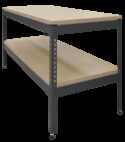Experiment
SM110
HOOKE'S LAW AND SPRING RATE
Tests extension springs to find their properties. Proves Hooke's law and the basic rules of spring design.
If you have any questions or you'd like to discuss a product, please call us.
+44 1159 722 611HOOKE'S LAW AND SPRING RATE
The Spring Testing Apparatus uses a fundamental variable mass and scale measurement to test springs. It shows students how to find the properties of a spring and proves some basic laws of physics (Hooke’s law, Newton’s law and spring design rules). It is also a useful tool for a workshop, to check the properties of a spring before it is used, or after it has been used.
The apparatus is a compact metal frame with adjustable feet so the user can make the apparatus level. The back of the frame has a storage area for springs and masses. The front of the frame has a metric scale each side of a large slot, where the test spring hangs.
Students choose a spring and note its dimensions. They then slowly load the spring with the masses (included) and note its extension against the metric scale. Students use their results to find the properties of the spring and compare them with theory and the manufacturer’s details. For more advanced studies, students can also do tests on springs in series and parallel.
The user guide (included) gives full details of how to use the equipment, spring theory, experiments and typical results.
Supplied with the apparatus is a set of extension or ‘tension’ springs. The user can compare different spring rates with different spring sizes to fully understand the basic rules of spring design. Tension springs also have the extra ‘initial tension’ that other springs do not have which increases students’ learning about spring properties.
Learning outcomes
- Spring rate and Hooke’s law
- To prove the basic rules of spring design
- A simple spring scale
- Springs in series
- Springs in parallel







